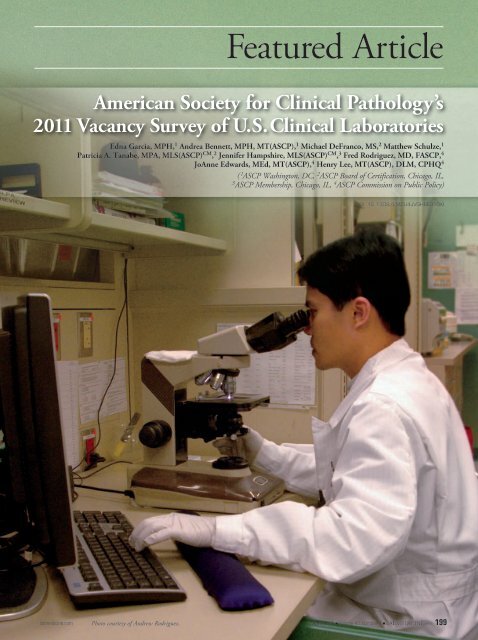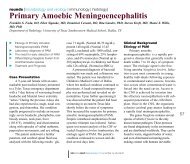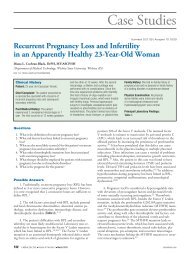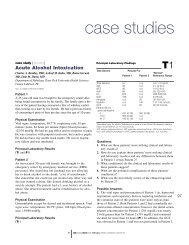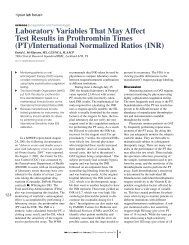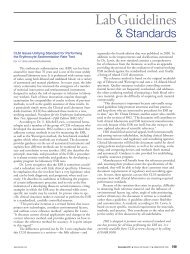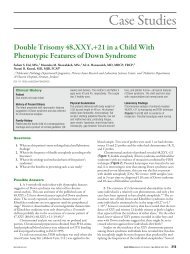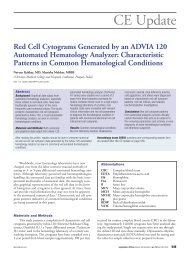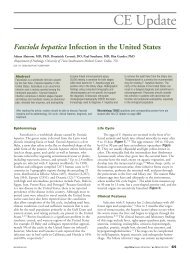2011 Vacancy Survey Of U.S. Clinical Laboratories - LabMedicine
2011 Vacancy Survey Of U.S. Clinical Laboratories - LabMedicine
2011 Vacancy Survey Of U.S. Clinical Laboratories - LabMedicine
You also want an ePaper? Increase the reach of your titles
YUMPU automatically turns print PDFs into web optimized ePapers that Google loves.
Featured Article<br />
American Society for <strong>Clinical</strong> Pathology’s<br />
<strong>2011</strong> <strong>Vacancy</strong> <strong>Survey</strong> of U.S. <strong>Clinical</strong> <strong>Laboratories</strong><br />
Edna Garcia, MPH, 1 Andrea Bennett, MPH, MT(ASCP), 1 Michael DeFranco, MS, 2 Matthew Schulze, 1<br />
Patricia A. Tanabe, MPA, MLS(ASCP) CM , 2 Jennifer Hampshire, MLS(ASCP) CM , 3 Fred Rodriguez, MD, FASCP, 4<br />
JoAnne Edwards, MEd, MT(ASCP), 4 Henry Lee, MT(ASCP), DLM, CPHQ 4<br />
( 1 ASCP Washington, DC, 2 ASCP Board of Certification, Chicago, IL,<br />
3 ASCP Membership, Chicago, IL, 4 ASCP Commission on Public Policy)<br />
DOI: 10.1309/LMZU4JVGH6EO1OXI<br />
labmedicine.com Photo courtesy of Andrew Rodriguez.<br />
April <strong>2011</strong> ■ Volume 42 Number 4 ■ LABMEDICINE 199
Featured Article<br />
Since 1988, the American Society for <strong>Clinical</strong><br />
Pathology (ASCP) has conducted its Wage and<br />
<strong>Vacancy</strong> <strong>Survey</strong> to provide the most recent<br />
wage data and determine the extent and distribution<br />
of shortages within the nation’s clinical<br />
laboratory workforce. This confidential survey<br />
has been administered every two years and has<br />
served as the primary source of information<br />
for academic, government, and industry labor analysts. While<br />
continuity remains a central objective in monitoring trends,<br />
the survey has evolved in response to changes within the profession.<br />
New questions have been added to the <strong>2011</strong> survey to<br />
examine some of the factors affecting wage and vacancy rates.<br />
This year, the ASCP Wage and <strong>Vacancy</strong> <strong>Survey</strong> has been administered<br />
as two separate surveys. Last month, the results of<br />
the Wage survey were published in <strong>LabMedicine</strong>.<br />
Methodology<br />
The <strong>2011</strong> <strong>Vacancy</strong> <strong>Survey</strong> was prepared by the ASCP’s<br />
Public Policy <strong>Of</strong>fice in Washington, DC and the Society’s<br />
Board of Certification (BOC), Chicago, IL. The survey was<br />
designed to be a web-based survey, which consisted of 13<br />
questions on vacancies, work shift issues, retirement, and hiring<br />
difficulties. Electronic invitations were sent on January<br />
11, <strong>2011</strong> via Zarca Interactive (an online survey vendor). The<br />
majority of these initial recipient email addresses were derived<br />
from the ASCP database, with the following partnering societies:<br />
American Association for <strong>Clinical</strong> Chemistry (AACC),<br />
American Medical Technologists (AMT), American Society of<br />
Cytopathology (ASC), American Society for <strong>Clinical</strong> Laboratory<br />
Science (ASCLS), American Society for Cytotechnology<br />
(ASCT), <strong>Clinical</strong> Laboratory Management Association<br />
(CLMA), and National Society for Histotechnology (NSH)<br />
contributing to the initial recipient cohort. To maximize survey<br />
response, recipients were allowed to forward the electronic<br />
survey invitation to fellow colleagues within the laboratory<br />
profession. Due to the recipient’s ability to forward the survey<br />
invite, however, an accurate rate of response cannot be calculated.<br />
The survey was closed on February 11, <strong>2011</strong>.<br />
The <strong>2011</strong> <strong>Vacancy</strong> <strong>Survey</strong> sought to collect staff- and<br />
supervisory-level data, as well as recruitment and retention<br />
information on the following laboratory areas and related<br />
certifications:<br />
• Anatomic Pathology<br />
• Blood Banking<br />
• Chemistry<br />
• Cytology<br />
• Cytogenetics<br />
• Hematology<br />
• Histology<br />
• Immunology<br />
• Microbiology<br />
• Phlebotomy<br />
The ASCP <strong>Survey</strong> administrators recognize there is no<br />
standard approach for how laboratories are organized. Laboratory<br />
areas may hire staff with a variety of certifications. ASCP<br />
provided survey participants with the opportunity to report<br />
on the certifications that exist or are sought after for the<br />
laboratory area under their supervision.<br />
Key Findings<br />
The primary objective of this research was to estimate<br />
the rate of shortage within clinical laboratory departments.<br />
Overall, this survey represents 625 facilities, 1,719 departments,<br />
16, 274 employees, and 17,674 positions from across<br />
the United States.<br />
According to the survey, phlebotomy, chemistry,<br />
hematology, and blood banking laboratory departments<br />
employ the majority of clinical laboratory personnel (Figure<br />
1). Across the nation, vacancy rates were highest for blood<br />
banking (11.6%), histology (9.81%), and chemistry (8.62%)<br />
departments. The lowest vacancy rates occurred in the departments<br />
of cytology (5.14%) and immunology (5.56%)<br />
(Table 1 and Figure 2).<br />
In general, hospitals with fewer than 100 beds and outpatient<br />
clinics reported higher vacancy rates compared to other<br />
facilities. For most of the laboratory departments surveyed,<br />
the lowest vacancy rates were found at hospitals with 300-<br />
499 beds. By region, (Table 2) the Far West reported higher<br />
vacancy rates than other regions while the South Central<br />
Atlantic had the lowest vacancy rates. Overall, survey results<br />
show that 47.23% of facilities do not perform molecular<br />
diagnostics, 24.72% of facilities have one central molecular<br />
diagnostics department, 21.52% of facilities have molecular<br />
diagnostics performed within specific laboratory departments,<br />
and 6.52% of respondents do not know if molecular diagnostics<br />
is performed at their facility.<br />
Blood Banking/Transfusion Medicine<br />
<strong>Of</strong> all the departments surveyed, blood banking/transfusion<br />
medicine had the highest overall (staff and supervisors)<br />
vacancy rate at 11.6% (Figure 2). The staff (non-supervisory)<br />
vacancy rate is 10.3%, while the supervisor vacancy rate is<br />
18.6% (Figure 3 and Figure 4). Blood Banking/Transfusion<br />
Medicine departments in hospitals with 500 beds or more<br />
have a higher staff vacancy rate, 13.5%, compared to other<br />
facilities in the survey. Hospitals with 300-499 beds report<br />
a lower staff vacancy rate, 7.03%, for the blood banking/<br />
transfusion medicine department. Sample size constraints<br />
prevented further analysis of vacancy rates for supervisory<br />
positions by facility. The vacancy rate for the blood banking/<br />
transfusion medicine department is highest in the Far West,<br />
15.2%, and lowest in the North East, 7.46%.<br />
Within blood banking/transfusion medicine, data show<br />
that 82.5% of staff employees and 76.6% of supervisors are<br />
certified (Figure 5). In addition, 19.6% of blood banking/<br />
transfusion medicine employees work double shifts or overtime<br />
(Figure 6). Molecular Diagnostics is performed in 4.42%<br />
of the total blood banking/transfusion medicine laboratories<br />
surveyed (Figure 7).<br />
Chemistry<br />
The total vacancy rate for the area of chemistry is 8.62%.<br />
(Figure 2) Overall staff vacancy rate is 8.22%, and overall<br />
supervisory vacancy rate is 11.6%. (Figure 3 and Figure 4) By<br />
facility, the staff vacancy rate is highest, 11.6%, in chemistry<br />
departments situated in hospitals with fewer than 100 beds.<br />
The staff vacancy rate is lowest in hospitals with 300-499<br />
beds, 6.62%. Due to sample size restrictions statistical analysis<br />
of vacancy rate for supervisory positions by facility could not<br />
be performed. The South Central Atlantic has the highest<br />
vacancy rate, 10.4%, and Central North West states had the<br />
lowest vacancy rate, 6.02%.<br />
200 LABMEDICINE ■ Volume 42 Number 4 ■ April <strong>2011</strong> labmedicine.com
Figure 1_Overall total number of employees by laboratory department.<br />
According to the survey results, 93.8% of staff and<br />
96.7% of supervisors working in chemistry laboratory departments<br />
are certified. (Figure 5) Employees who work overtime<br />
or double shifts constitute 17.5% of the total workforce in the<br />
department (Figure 6). Results show that molecular diagnostics<br />
is performed in 8.82% of Chemistry laboratories surveyed<br />
(Figure 7).<br />
Cytology<br />
The overall vacancy rate for the cytology department is<br />
5.14%, the lowest across all surveyed departments (Figure 2).<br />
Total staff vacancy rate is reported to be 2.67%, and total<br />
supervisor vacancy rate is 18.55% (Figure 3 and Figure 4).<br />
Analysis of vacancy data by laboratory facilities and region<br />
Featured Article<br />
Figure 2_<strong>Vacancy</strong> rates by laboratory department. *Sample sizes for Anatomic Pathology and Cytogenetics did not allow for statistically<br />
significant comparisons.<br />
Table 1_Total Number of Responses per Department<br />
Department N<br />
Anatomic Pathology 68<br />
Blood Banking 226<br />
Chemistry 272<br />
Cytogenetics 28<br />
Cytology 189<br />
Hematology 272<br />
Histology 146<br />
Immunology 121<br />
Microbiology 181<br />
Phlebotomy 216<br />
Total 1719<br />
labmedicine.com April <strong>2011</strong> ■ Volume 42 Number 4 ■ LABMEDICINE 201
Featured Article<br />
Table 2_Regional Distribution by State<br />
Region States<br />
Far West Alaska (AK), Arizona (AR), California (CA), Colorado (CO),<br />
Hawaii (HI), Idaho (ID), Montana (MT), Nevada (NV),<br />
New Mexico (NM), Oregon (OR), Utah (UT),<br />
Washington (WA), Wyoming (WY)<br />
Central North West Iowa (IA), Kansas (KS), Minnesota (MN), Missouri (MO),<br />
Nebraska (NE), North Dakota (ND), South Dakota (SD)<br />
Central South West Arkansas (AR), Louisiana (LA), Oklahoma (OK),<br />
Texas (TX)<br />
Central North East Illinois (IL), Indiana (IN), Michigan (MI), Ohio (OH),<br />
Wisconsin (WI)<br />
South Central Atlantic Alabama (AL), Delaware (DE), District of Columbia (DC),<br />
Florida (FL), Georgia (GA), Kentucky (KY), Maryland<br />
(MD), Mississippi (MS), North Carolina (NC), South<br />
Carolina (SC), Tennessee (TN), Virginia (VA), West<br />
Virginia (WV)<br />
Northeast Connecticut (CT), Maine (ME), Massachusetts (MA),<br />
New Hampshire (NH), New Jersey (NJ), New York<br />
(NY), Pennsylvania (PA), Rhode Island (RI),<br />
Vermont (VT)<br />
could not be performed as the results would provide statistically<br />
insignificant values.<br />
<strong>Survey</strong> results show that 90.7% of staff and 98.0% of<br />
supervisors in the cytology department are certified (Figure 5).<br />
Employees in the cytology department who work double shift<br />
or overtime make up 6.87% of the total laboratory personnel<br />
employed in the facility. This relatively low number is likely<br />
reflective of the workload limits placed on cytotechnologists<br />
by the <strong>Clinical</strong> Laboratory Improvement Amendments of<br />
1988 (CLIA) (Figure 6). Molecular diagnostics is performed in<br />
22.2% of the Cytology laboratories in the survey (Figure 7).<br />
Hematology<br />
The overall vacancy rate for the hematology department<br />
is 7.0%. (Figure 2) The staff vacancy rate is 6.91%, and the<br />
supervisor vacancy rate is 7.65%. (Figure 3 and Figure 4) Hematology<br />
departments in hospitals with 100 beds or less have<br />
a relatively higher staff vacancy rate of 8.03%, compared to<br />
Figure 3_Staff vacancy rates by laboratory department. Sample sizes for Anatomic Pathology and Cytogenetics department did not allow for<br />
statistically significant comparisons.<br />
Figure 4_Supervisory vacancy rates by laboratory department. Sample sizes for Anatomic Pathology, Cytogenetics, and Immunology did not<br />
allow for statistically significant comparisons.<br />
202 LABMEDICINE ■ Volume 42 Number 4 ■ April <strong>2011</strong> labmedicine.com
other facilities surveyed. Hospitals with 300-499 beds reported<br />
a lower vacancy rate of 6.65%. By region, the total vacancy rate<br />
for the Hematology department is higher in the Central South<br />
West, 11.2%, and lower in the South Central Atlantic, 5.88%.<br />
According to the survey results, 94.3% of staff and<br />
93.4% supervisors in the hematology department are certified.<br />
(Figure 5) Furthermore, 16.3% employees in the department<br />
work double shifts or overtime. (Figure 6) Molecular diagnostics<br />
is performed in 4.78% of the total hematology laboratories<br />
surveyed. (Figure 7)<br />
Histology<br />
The overall vacancy rate for the histology department is<br />
9.81% (Figure 2). The total staff vacancy rate is 8.50%, and<br />
the total supervisor vacancy rate is 17.8% (Figure 3 and Figure<br />
4). Further analysis of overall vacancy rates by region and facility<br />
for histology laboratories could not be performed as the<br />
results would be rendered statistically insignificant.<br />
<strong>Survey</strong> results show that 69.4% of staff and 91.6% of<br />
supervisors in the histology department are certified (Figure<br />
5). <strong>Of</strong> the total staff and supervisors employed in this department,<br />
20.9% work double shifts or overtime (Figure 6).<br />
Molecular Diagnostics is performed in 9.59% of the total<br />
Histology laboratories in the survey (Figure 7).<br />
Immunology<br />
The vacancy rate for the immunology department is<br />
5.56% (Figure 2). Due to sample size restrictions, statistical<br />
analysis of vacancy rates for staff and supervisor, facility, and<br />
region could not be performed.<br />
According the survey results, 95.4% of staff and 97.9%<br />
of supervisors in the immunology department are certified<br />
(Figure 5). Employees who work double shifts or overtime<br />
constitute 22.8% of the total workforce in the department<br />
(Figure 6). Molecular diagnostics is performed in 9.92% of<br />
the total immunology laboratories in the survey (Figure 7).<br />
Figure 5_Percentage of certified employees by laboratory department.<br />
Microbiology<br />
Featured Article<br />
The total vacancy rate for the microbiology department<br />
is 6.81% (Figure 2). The total vacancy rate for staff is 5.99%,<br />
and the total vacancy rate for supervisors is 11.8% (Figure<br />
3 and Figure 4). By facility, the staff vacancy rate is highest<br />
in outpatient clinics, 23.1%, and lowest in hospitals with<br />
300-499 beds, 4.3%. Analysis of supervisory vacancy data by<br />
laboratory facility and vacancy rate region were not performed<br />
as the results would be statistically insignificant.<br />
<strong>Survey</strong> results show that 91.4% of staff and 98.3% of<br />
supervisor in the microbiology department are certified (Figure<br />
5). In microbiology, 12.5% of employees work double shifts<br />
or overtime (Figure 6). Molecular diagnostics is performed in<br />
37.0% of the total microbiology laboratories surveyed (Figure 7).<br />
Phlebotomy<br />
The national vacancy rate yield for phlebotomy is 7.91%<br />
(Figure 2). The overall staff vacancy rate is 7.89%, and the<br />
supervisor vacancy rate is 8.20% (Figure 3 and Figure 4).<br />
Phlebotomy departments in outpatient clinics have a higher<br />
staff vacancy rate, 18.9%, compared to the other facilities in<br />
the survey. Hospitals with 300-499 beds have a lower staff vacancy<br />
rate of 6.37%. Due to sample size restrictions, statistical<br />
analysis of the vacancy rate for supervisory positions by facility<br />
could not be performed. By region, Central South West has<br />
the highest overall vacancy rate of 12.7%, and Central North<br />
East has the lowest total vacancy rate of 6.10%.<br />
Data results show that 48.1% of staff and 82.8% of supervisors<br />
are certified in the phlebotomy department (Figure<br />
5). Employees who work double shifts or overtime constitute<br />
17.5% of the total workforce in the department (Figure 6).<br />
Anatomic Pathology<br />
According to the survey results, 46.3% of staff and 76.6%<br />
of supervisors in the anatomic pathology department are certified<br />
(Figure 5). Employees who work double shifts or overtime<br />
labmedicine.com April <strong>2011</strong> ■ Volume 42 Number 4 ■ LABMEDICINE 203
Featured Article<br />
Figure 6_Percentage of employees who work double shifts or overtime by department.<br />
Figure 7_Percentage of laboratories by department that perform Molecular Diagnostics.<br />
Figure 8_Time to fill empty staff positions.<br />
204 LABMEDICINE ■ Volume 42 Number 4 ■ April <strong>2011</strong> labmedicine.com
constitute 13.1% of the total workforce in the department<br />
(Figure 6). Molecular diagnostics is performed in 7.35% of the<br />
total anatomic pathology laboratories in the survey (Figure 7).<br />
Further analysis of overall vacancy rate, staff and supervisory<br />
vacancy rates, as well as vacancy rates by region and facility for<br />
anatomic pathology laboratories could not be performed as the<br />
results would be rendered statistically insignificant.<br />
Cytogenetics<br />
Data show that 85.4% of staff and 97.8% of supervisors<br />
in the cytogenetics department are certified (Figure 5). <strong>Of</strong> the<br />
total employees in this department, 20.1% work double shifts<br />
or overtime (Figure 6). Molecular diagnostics is performed in<br />
57.14% of the cytogenetics laboratories, the highest of all the<br />
laboratory departments surveyed (Figure 7). Further analysis<br />
of overall vacancy rate, staff, and supervisory vacancy rates,<br />
as well as vacancy rates by region and facility for cytogenetics<br />
laboratories could not be performed as the results would be<br />
rendered statistically insignificant.<br />
Challenges Facing the Laboratory<br />
Workforce<br />
Hiring Difficulties<br />
Nationally, the majority of laboratories filled most positions<br />
within six months of posting an opening. At the staff<br />
level, vacancies in the histology and microbiology departments<br />
took longer to fill (Figure 8). At the supervisor level, histology<br />
and blood banking/transfusion medicine supervisory positions<br />
were the hardest to fill, at 24.0% and 23.0%, respectively, of<br />
laboratories across the country taking more than one year to<br />
fill a vacancy (Figure 9).<br />
Featured Article<br />
The night shift was the most difficult time slot to fill.<br />
Immunology and Phlebotomy departments however, reported<br />
difficulties in hiring for the day shift. According to the survey,<br />
the majority of laboratories across the nation state “better pay<br />
and/or benefits at other area laboratories” and “lack of necessary<br />
education and skills to perform the work” as the primary<br />
reasons for hiring and recruiting difficulties in their departments.<br />
Furthermore, most of the laboratories in the survey reported<br />
that their departments do not use any recruitment or retention<br />
initiatives to attract employees.<br />
Retirement<br />
Retiring baby boomers from all departments pose yet another<br />
staffing challenge for the clinical laboratory field. According<br />
to the laboratories from the survey, Immunology has the highest<br />
percentage of employees expected to retire in the next five years.<br />
Anatomic Pathology and Phlebotomy have the lowest rates of<br />
employees expected to retire in the next five years (Figure 10).<br />
Summary<br />
When hiring staff-level (non-supervisory) employees, most<br />
respondents report Medical Laboratory Scientist/Medical Technologist/<strong>Clinical</strong><br />
Laboratory Scientist (MLS/MT/CLS) and<br />
Medical Laboratory Technician/<strong>Clinical</strong> Laboratory Technician<br />
(MLT/CLT) as the preferred credential/certification. The Phlebotomy<br />
department prefers Phlebotomy Technicians (PBTs)<br />
and Non-Certified personnel when hiring staff-level employees.<br />
Histotechnician (HT) is the credential/certification of choice<br />
in the histology department when hiring staff-level personnel.<br />
The Cytology department reports that when hiring staff-level<br />
employees, Cytotechnologist (CT) is the preferred credential/<br />
certification. Lastly, Pathologists’ Assistant (PA) is the credential/<br />
labmedicine.com April <strong>2011</strong> ■ Volume 42 Number 4 ■ LABMEDICINE 205
Featured Article<br />
Figure 9_Time to fill empty supervisory position.<br />
Figure 10_Percentage of employees by department anticipated to retire in the next 5 years.<br />
certification of choice when hiring staff-level employees in the<br />
Anatomic Pathology Department.<br />
For the most part, laboratory departments surveyed prefer<br />
MLS/MT/CLS credential/certification when hiring supervisory<br />
employees. Some departments, however, also chose other<br />
credentials/certifications based on their laboratory’s needs.<br />
The following hire supervisory level employees with certain<br />
credentials/certifications: Anatomic Pathology – PA and HT,<br />
Blood Banking - Specialist in Blood Banking (SBB), Cytogenetics<br />
– Technologist in Cytogenetics (CG), Cytology – SCT/<br />
CT, Hematology - Specialist in Hematology (SH), Histology<br />
– HTL/HT, Microbiology - Specialist in Microbiology (SM),<br />
and Phlebotomy – Phlebotomy Technician (PBT).<br />
The data also indicate that supervisors are more likely to<br />
be certified than staff. This suggests that employers consider<br />
certification a desirable qualification when hiring or promoting<br />
laboratory staff. Thus, individuals may find that certification<br />
increases the likelihood of advancing into managerial or<br />
supervisorial roles within the laboratory.<br />
Laboratory medicine is a rapidly evolving field. Advances<br />
in genomics and automated technology are redefining the<br />
workforce skills necessary to meet the demand of tomorrow’s<br />
laboratory. In addition to these changes, the nation’s clinical<br />
laboratories continue to be plagued by challenges of recruiting<br />
and retaining staff. Other top issues affecting recruitment were<br />
workload stress, scheduling, limited potential for advancement/<br />
additional training, budget constraints, and commuting issues.<br />
Unfamiliarity with the profession due to lack of public<br />
visibility and limited opportunities for advancement are also<br />
contributing factors. Changes in hiring criteria for laboratory<br />
personnel, coupled with a declining interest in laboratory<br />
medicine as a career over the past two decades has led to the<br />
closure of numerous medical technologist training programs.<br />
There are many dimensions to the current shortage of welltrained<br />
and qualified laboratory personnel, and understanding<br />
the reasons for it will be essential in planning a systematic<br />
strategy to address the issues at hand. A coordinated effort<br />
involving laboratory organizations, government agencies,<br />
clinicians, health administrators, outside stakeholders, and<br />
industry partners will be needed to formulate a long-term<br />
solution. LM<br />
206 LABMEDICINE ■ Volume 42 Number 4 ■ April <strong>2011</strong> labmedicine.com


